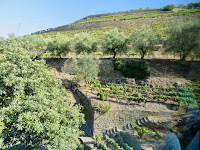 |
| Peso da Régua waterfront |
On approaching the Douro Valley, we passed several active fires in the nearby mountains. Luckily, most of them seemed to be well contained and on our arrival in Peso da Régua, the air was clear. Finding the hostel was a challenge. When our GPS said our street in Peso didn't exist, we were not surprised. Our replacement rental vehicle had an old Garmin unit which had clearly not been updated since its production. It led us up narrow village streets (with dwellings only inches from the car mirrors). It had no knowledge of major highways, which had clearly been around for 10 years or more. It took us up a private driveway and down a road which was somewhat akin to a cow path. Contacting the hostel using our emergency phone, the patient receptionist kept in contact with us over several minutes and led us to our accommodations.
 |
| Marrocos' estate |
Vinicultural activity has been taking place on the property for over 4 generations. Producing primarily port wines, only 20% of their crop is used for creating white, red, or rose table wines.
Joining another scheduled tour, we learned how the grapes become wine. We were surprised to learn that grape stomping is a vital part of the process. So a variation of the
I Love Lucy TV episode of The Italian Movie filmed in 1956 is still taking place, minus the grape fight. (If you are too young to remember this, check it out on YouTube.) Several stompers climb into the 10X10 concrete vat and stomp the grapes in a specific manner. For unskilled labor, stomping is considered one of the better jobs, they are inside protected from the sun and earn 7 euros an hour, the grape pickers, climbing steep terraces and carrying heavy baskets of fruit, earn 40 euros a day.
Following the tour, we gathered in a room decorated with artifacts from the family's history on the property. We were here for the serious business of tasting some of the ports they sell and got a brief education on the different varieties; white, tawny, ruby, and vintage. Ports are sweet and are typically served as a dessert wine. We wound up leaving with one bottle of dry white, for my new favorite cocktail, Porto Tónico. During our visit, we learned that rooms were available to rent at the estate as well, so maybe next time......
Moving back to Peso, we were able to catch the final boat tour for the day along the Doura River. Though the drive through the valley is considered one of the most beautiful in Europe, it was next to impossible for Alan to enjoy as he concentrated on maneuvering along the zigzagging roadway. So, the tour was a welcomed opportunity for him to see the areas he had been driving through. Across from Peso, high on a ridge, we saw the silhouette of the Sandeman logo. Producing ports since 1790, the company's logo looks like a Zorro figure overlooking the valley, and it's visible from just about anywhere near the water.
With our brief visit to Douro complete, it was time to move on to Porto the following morning.
 |
| These kegs hold over 20,000 liters of the fortified port as it ages. |
 |
| Douro dam |






No comments:
Post a Comment